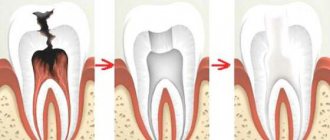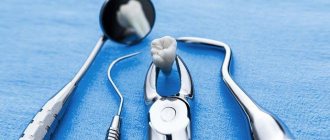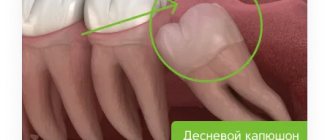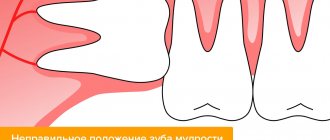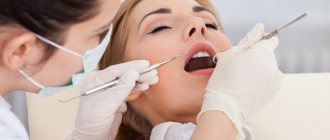Author: Brodsky Sergey Evgenievich Deputy Chief Physician, Candidate of Medical Sciences in the specialties: dentistry and medical microbiology Techniques for tooth extraction depend on the number of its roots, the clinical situation and surgical instruments. You can learn about how the process of tooth extraction occurs in this article.
- What instruments are used to remove teeth?
- How does the tooth extraction process work?
- How is a complex tooth extraction performed?
- When is complex tooth extraction required?
What instruments are used to remove teeth?
Depending on the clinical situation, the instruments used to remove teeth may be needed in different combinations, or the doctor may be content with just one.
1) Tooth extraction forceps
- There are forceps for removing upper and lower, front and back teeth. In addition, there are so-called universal (button) dental forceps for extracting any tooth. For third molars, which are displaced towards the tongue or cheek during eruption, there are special forceps for removing wisdom teeth, which allow you to very tightly cover the crown part of the eighth teeth. There are also special root forceps for removing only one root from the bone tissue.
Deputy Chief physician Sergey Evgenievich Brodsky
Sign up for a free consultation
+7
2) Elevators for dental extraction
- This type of tool is made in the form of a sharpened screwdriver with a groove, with which you can pick up and dislocate a tooth or a separate tooth root. There are a great many options and types of dental elevators. For wisdom teeth, there is a special elevator, the so-called “Lecluse Key,” which facilitates the dislocation of eighth teeth that are tightly seated in the jaw.
Elimination Features
To eliminate a damaged tooth, an elevator is inserted between the wall and the root; for multi-rooted units, between the individual elements of the root. The concave side faces the tooth, the convex side faces the socket. The doctor presses on the handle and forgives the instrument, moving its working part deeper. The success of removal depends on how correctly the dentist chooses the type of instrument and performs the operation. Before starting work, you need to carefully examine the damaged and removed tooth and evaluate the strength of the crown part. If the external crown is in the way, its preliminary removal is indicated.
Elevator usage options:
- With slight bending, the root part is deflected, the socket is enlarged, and the unit being removed is dislocated.
- For third molars, sectioning and insertion of the cheek from the distal side are necessary. The dental crown is displaced and the units are removed.
- If the roots are sufficiently bent, it is necessary to rupture the periodontal ligaments. To do this, the tooth is divided into three separate parts using special tools, which are removed one by one.
- In case of buccal as well as lingual curvature, the elevator widens the periodontal gap, after which removal is carried out.
- If the alveolar process is of significant thickness or the crown is significantly destroyed, the cheek is inserted between the root part and adjacent units.
- The straight type of instrument is used to extract figure eights; the working part is carefully inserted along the surface of the tooth, after which it is removed.
Before starting the procedure, you must thoroughly sterilize the elevator and other instruments. First, they are soaked in an antiseptic solution and washed in clean running water. The next step is immersion in the biolot, heated to 40 degrees. The instruments are dried before use.
How does the tooth extraction process work?
The process of tooth extraction proceeds according to the following scheme:
- Pain relief with local anesthesia;
- Selection of tools for dental extraction (elevator and/or forceps);
- Applying forceps or an elevator to the tooth being removed;
- Rocking or dislocation of the “sentenced to be removed”;
- Extracting a tooth from the jaw socket;
- Toilet (care and protection) of the surgical wound left after tooth extraction.
In this scheme, there may be additional stages when, before tooth extraction, a lot of the root tooth is first sawed and pulled out of the bone socket in parts. This option is required for crooked and twisted roots.
Healing process after surgery
After surgery, the recovery period begins. The duration of its continuation is individual, as a rule, 1-2 days. In particularly advanced clinical situations, negative symptoms may persist for about 5-7 days. After a few hours, the effect of the anesthetic wears off, causing the patient to experience severe discomfort. If the pain is pronounced and does not go away on its own, experts prescribe non-steroidal anti-inflammatory drugs and analgesics.
The day after the operation, redness and slight swelling may occur in the area affected by surgical instruments. It gradually goes away on its own when the blood supply to the area is normalized. Sometimes the patient needs to take antibacterial agents (as prescribed by the attending physician).
Immediately after tooth extraction, bleeding may occur. This is due to the fact that a small bloody clot appears in the formed hole. Most often, it can be stopped in the dental chair, but for some, the hemorrhage continues for another 1-2 days. Prolonged bleeding may be due to a number of factors, such as high blood pressure or a bleeding disorder.
To avoid the appearance of hemorrhagic syndrome, it is important to strictly follow all the instructions of the surgeon. People suffering from hypertension are advised to drink motherwort tincture before tooth extraction. With its help, the functioning of the nervous system is normalized and there will be no surges in blood pressure. To monitor the healing process after surgery, you need to see a dental surgeon on days 5-7. There is usually no need to remove sutures as they dissolve on their own. To avoid complications during the recovery period, the following measures are required:
- During the first days, it is recommended to brush your teeth with a soft brush and be especially careful so as not to touch the soft tissues. This will avoid bleeding;
- You should not eat food for the first 2-4 hours. Throughout the entire recovery period, only soft foods and drinks at room temperature are recommended. Chewing on the operated side is prohibited;
- do not rinse your mouth or take baths for the first 24 hours;
- do not undergo strenuous physical activity. Such actions cause an increase in blood pressure, which can lead to hemorrhage.
How is a complex tooth extraction performed?
Options for non-standard tooth extraction are required in different clinical situations. The most common option is the difficult removal of the eighth tooth, especially when it has not fully erupted or is generally lying and completely immured in the jaw.
The most commonly used method for complex tooth extraction is:
- Conducting anesthesia;
- Creating access to the tooth to be removed, dissecting the mucous membrane and periosteum, forming an evacuation window in the bone tissue of the jaw, in which the unerupted (impacted) tooth is hidden;
- Extracting a tooth from the jaw using an elevator;
- Toilet of the surgical wound, including treatment with furatsilin and rinsing with hydrogen peroxide, filling the voids from under the extracted complex tooth with bone powder, applying a membrane and suturing the gums;
- Prescription of anti-inflammatory therapy.
Main indications and contraindications
Complex removal is required in a number of complex clinical cases when it is not possible to perform surgical intervention using standard techniques and instruments. Very often it is carried out in relation to the last painters (“eights”). As a rule, they do not have enough space, against which they begin to grow incorrectly (for example, erupt towards the cheek, injuring the mucous membrane), slowly erupt, accompanied by painful sensations. The last molars do not participate in the chewing process, so most often the dental surgeon decides to remove them in such situations.
Complex surgical procedures are resorted to in the presence of a chronic inflammatory process, against the background of which the bone tissue and the molar or premolar itself have fused. A complex operation cannot be avoided if the molar has several roots or its area is severely curved. Benign neoplasms (for example, granulomas or cysts) are often an indication for removal if the tooth is destroyed and there is no point in trying to restore it. Sometimes a complex extraction of a previously treated tooth is performed several times. This is due to the fact that it is not durable, its density is weakened, and it is capable of cracking.
As with any surgical intervention, there are a number of absolute and temporary contraindications to complex removal of molars or premolars. Among them:
- diseases of viral etiology;
- serious deviations from the cardiovascular system;
- pregnancy and lactation;
- blood diseases (anemia, poor clotting, leukemia);
- chronic pathologies during exacerbation;
- recent strokes and heart attacks;
- serious mental disorders (schizophrenia);
- long-term use of medications that affect blood clotting.
When is complex tooth extraction required?
Clinical situations in dentistry when tooth extraction is considered difficult are:
- Tooth with a cyst;
- Dystopic or impacted wisdom tooth;
- Fistula in the projection of the tooth;
- Removal of premolars in the treatment of malocclusion;
- Removal of baby teeth in children;
- Abnormally crooked roots directed in different directions.
To successfully remove complex teeth, in each individual case, the dental surgeon can use a combination of different tools and methods that are most suitable for successfully extracting teeth and roots from the jaw.
Just CALL US!
+7
We will answer any of your questions and will definitely help you!
Types of elevators
Such a tool is indicated for removing dystopic units with a significant degree of curvature of the roots. In appearance, it is a lever consisting of a cheek (or spoon), a handle and a long middle element. The working part can be spear-shaped, rectangular or oval. It is directed at different angles, can be symmetrical or asymmetrical, mirrored. This variety allows you to choose the tools that are optimally suited for work in certain cases.
The following types of instruments are used in dentistry: angular, bayonet-shaped and straight. Elevators with a bayonet-shaped working part are straight; this is a type of elevator for narrow tasks. some models are called by the name of the developer - Vinta, Potta, Lecluse and others.
Straight models have pointed sides of the spoon, in some cases there are notches on the edges. They are indicated for the removal of roots, dystopic units, and third molars in the upper jaw. The most famous is the straight Lecluse elevator, which is similar in shape to a corkscrew. Indications: removal of figure eights on the lower jaw. Lateral instruments are used for root extraction on the lower jaw and in case of severe destruction of the crown, when it is not possible to work with forceps.
Corner models are distinguished by the presence of a spoon with a bend of up to 120 degrees. The tool has a lever effect and quickly removes teeth in a dystopic position or roots. The cheek is oval or spear-shaped, with jagged or smooth surfaces on the sides. The most effective devices include Barry, Winter and others, equipped with a perpendicularly located middle part, which makes luxation quick and convenient.
The bayonet-shaped design has combined cheeks, one side of which is convex, the other is smooth. The tool is a straight elevator and can be used to destroy a crown.
Why are complex teeth treated at PARTNER-MED?
We know how to work!
We have orthopedic dentists with 8-30 years of experience!
We love to work!
We will give you a free consultation and tell you exactly how best to make your teeth better!
We are responsible for the result!
We work conscientiously and will make your teeth LIKE YOURSELF!
Request a call back or dial our number!
+7
This phone call does not obligate you to anything. Just give us a chance and we will help you!
Just pick up the phone and call us!
+7
We will definitely make you an offer that you cannot refuse!
Complications
Deterioration during removal rarely develops. But such a situation is still possible; in some cases, the Patient’s condition seriously worsens, especially if the doctor violates the removal technology. In practice, the following complications are noted:
- damage to blood vessels, which causes severe bleeding;
- removal, serious damage to the primordia of permanent units when removing milk;
- puncture wounds of tissue due to puncture of instruments, in this situation there is a high risk of damage to the carotid artery and other large vessels;
- development of an infectious lesion, alveolitis (if the instrument is not properly sterilized);
- ruptures, dislocations of ligaments;
- breakage, part of the elevator getting stuck in the wound;
- fractures of hard tissues when the load is exceeded towards the tips of the root part.
Rare cases include the formation of a granuloma in the area where the unit was removed. After eliminating the cyst, part of the nail of the doctor who performed the extraction was found in the tissue. Apparently it was cut off with an instrument during surgery.
Elevators are indicated for use if the coronal part is destroyed or for other reasons it is not possible to use forceps. For the operation, local anesthesia is used, which allows the Patient not to feel pain or discomfort.
